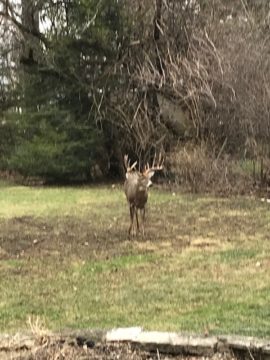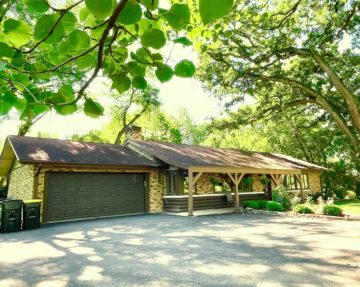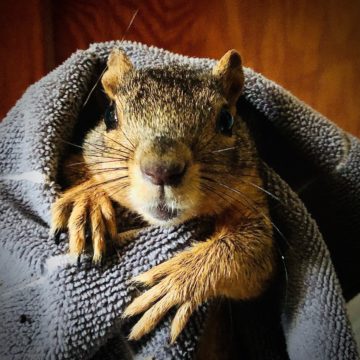by Carol A Westbrook

We bought a little house in a development called Timber Trails, Oak Brook, IL in December of 2019. Our house was old and in need of repair, but the lot was very large—almost an acre in size. It was full of ancient oak trees, some almost two centuries old, providing a canopy of some thirty to fifty feet high. Our backyard was immediately adjacent to York Woods, a Du Page County Forest preserve, through which Salt Creek flowed. Soon we felt that we lived in these woods, with woodland animals our nearest neighbors.
There were dozens of chipmunks and squirrels with their funny antics; hungry rabbits to raid the garden; raccoons to raid the trash cans; there even was a fat, grumpy groundhog who lived under the deck, ready for hibernation—we expected to see him in the spring. Were we surprised to find that he was a she, who was followed around the yard by two adorable baby groundhogs! There were a surprising number of birds, even in winter. The non-migratory birds included sparrows, robins, one variety of blue jays, and the rare flash of red with the “purty,purty” call of the cardinal. Of the large mammals, we saw the occasional coyote, and numerous white-tailed deer.
During the spring and summer we’d see deer in groups of two or three does with their young fawns, and an occasional yearling tagging along. They’d browse our garden plants and shrubs, moving along to cross the street, always at the “Deer Crossing” sign. In winter, deer do not hibernate; instead they sleep a lot, minimizing activity and conserving energy. On warmer days they will walk the neighborhood and browse whatever edible plant material they find—usually from the plants in my garden! Many of the lone females who are out in the winter, looking for food, are pregnant, since rut (the mating season) happens in November.
It was in November of 2020, the first year we lived in Timber Trails, that we saw the most remarkable sight. It was a very large 16-point buck. This large animal stepped warily out of the forest, proudly holding his head up and scanning the yard. He then walked slowly through it, always following the herd of doe, looking as if he owned the place. He had the bearing of a king! To me, he was King of the Forest!

I saw him only twice more that year. The last time was on Christmas Eve, and I told my grandchildren that he was waiting to hitch to Santa’s sled. I never saw him again, though I often saw him in my dreams.
These woodland animals became close companions when the Covid-19 lock down began, a few months after we moved in. Suddenly, our social life stopped, and so did the visits to our family, and to the gym. I spent a lot of time watching the animals.
The Mallards
The fall and winter were wet, as they had been the prior year as well, so spring came in, as E.E. Cummings wrote, “puddle-wonderful”. Our yard was not very far from Salt Creek, and it was soggy and wet, and there was a little pond close to the woods. When spring brought the return of the migratory birds, we were visited by a pair of mallard ducks, whom I called “Maude” for the female and “Claude” for the male. I imagined their conversation to go something like this:
“Are you sure we’re going the right way, Maude?”
“They said go straight north, until you see the big water, then turn left, go another half day, then look for the very long creek that winds through the human’s towns (Salt Creek). Then you’ll see the little lake with the swans in it—that’s our summer home.”
“But Maude, I can’t remember which is left and which is right!”
Claude was not the smartest Mallard, but Maude married him for his looks, and Claude was certainly a beautiful, colorful duck, with his red breast and white undersides, his green head and neck encircled by a white neckband. He was unlike herself, with her plain brown feathers.
“Well, Claude, which hand do you write with? That’s the right hand, the other is the left.”
“But Maude,” Claude protested, “ducks don’t have hands and they certainly can’t write!”
“Oh never mind! Just follow me,” said Maude.

Soon they found the little pond in our yard, and settled down. They took a big swallow of fresh water, and began to munch on the surrounding leaves.
At that point, I noticed them and brought out some pieces of stale bread. I couldn’t get too close or they would fly away, honking for all they were worth. So I tore up the bread and quietly put it down about 25 ft away from the pond and backed away. They devoured it ravenously. I came several times a day to feed them, and sdoon, when they saw me, they would leave the water and come up toward me, but never too close. They would climb the stairs up to the deck if I left food for them, with Claude always urging Maude to go first, as you can see in the video. Maude was definitely the more aggressive of the two when it came to feeding, but then again her first clutch of eggs was growing in her belly, and that’s 5 or 6 more mouths to feed.
When my Facebook friends saw that I was feeding bread to the ducks, they complained that I should be giving them natural food, like seeds and nuts instead of bread. So I went to a pet shop and bought parrot food, with its mix of seeds, nuts, and bird pellets; sure enough, they preferred this to bread. They came up the deck stairs, but never approached the stainless food bowl I bought for them, preferring to peck through the grass for the food. If they saw me on the deck or walking on the lawn, they would leave the pond and head for me. I had visions of the Mallards moving into the pond permanently, and Maude laying her first clutch of eggs. I imagined them parading to me for handouts, with their little ducklings following close behind.
That’s not what happened. Instead, the pond began to shrink as the spring weather warmed up.
“Claude, have you noticed what’s happening to our pond?” asked Maude.
“No, what is it now?” Claude was preening himself, and looking at his beautiful reflection in the pond water, barely paying attention to Maude.
“It’s not a real pond, with fish and tadpoles, mosquito larvae and other bugs. It’s just a puddle of muddy water, and it’s drying up! We can’t raise our ducklings and teach them to feed themselves, or make a nest to come home to after returning from the Big Journey south. We need to move into a real pond, and we need to move NOW! I’m almost ready to lay these eggs and raise a family.”
And so they took off, just like that.
I saw them a few weeks later in the pond in the Town park, a natural pond that was fed by Salt Creek. Maude was proudly leading her ducklings around, while Claude was preening and admiring his reflection in the water. I brought along some bread, but they didn’t even look twice at me .
A Squirrel’s Tail (Tale)
The squirrels in our trees provided hours of entertainment as they chased each other up and down and around the trees. A quick flick of the tail provided a challenge to another squirrel, whereupon a chase ensued, and stopped just as suddenly. The squirrels chased each other all day, and I wondered where they got all their energy. The chase became much more furious during the spring mating season. During those times you’d see a female squirrel slowly flicking her tail, looking coquettishly back, challenging them to catch her. A busy chase would follow with 3 or 4 boy squirrels participating, doing somersaults and scampering around the tree, until she outran them–she stopped and wiggled her backside and her tail—and the chase began anew, until she let herself be caught.
Our squirrels lived in nests high in the trees, 30 to 50 feet up! They were amazingly sure-footed, but they did, sometimes, fall out of trees, though it was a rare occasion.
Once, while doing some yardwork, we found what we thought was a dead squirrel in the lawn. Then we noticed that the squirrel was moving its front legs. In trying to run away, the only way it could do this was by pulling itself forward by its front legs, since the tail and rear legs didn’t work. Poor baby–and yes, it looked like a baby, since the tail was small and not yet bushy.

I looked for placement for this creature in an animal shelter. Willowbrook Wildlife preserve would take the animal only if we brought it in–but that was not possible for me. However, they said they would post the request for squirrel retrieval, and within a half hour I got a call from Kristina.
Kristina, is a Licensed Wildlife Rehabilitator; as such, she works with wounded animals with the goal of having them be returned to their natural habitat. She runs a shelter called “Kristina’s Critters,” and specializes in squirrel rehab. So, after a number of questions, Kristina determined she could take the animal, and would come right over.
In a few minutes Kristina showed up. In the meantime, the squirrel had pulled itself along, uphill, over 25 feet, stopping when she came to a suitable refuge–a drainpipe. This was fortunate for us, since it was relatively easy for Kristina to reach it with her long leather gloves, and get the squirrel out and into a blanket. After looking her over, Kristina said that the squirrel was a “she.”
Though the squirrel had the symptoms of a spinal break—paralysis of lower legs and tail and no ability to urinate–Kristina believed that the spine was just bruised, with the symptoms being due to spinal compression by inflammation, which will slowly resolve with medical care and rehabilitation. Eventually, as this resolves, she should regain all of her lost function.
This proved to be the case. Later that evening Kristina sent me a text, which read: “She’s got a great temperament, just gotta keep giving her meds and hope she can regain some feeling once the swelling and inflammation goes down.” If she can’t manage, then she will be put down.
Kristina, named her “Beatrix” from the Latin meaning “wanderer, voyager.” The name fit her well. A few days later she began to regain some control of her lower body. First her tail twitched, then she regained the withdrawl reflex in both lower limbs. Finally, she deliberately peed on Kristina’s hands (out of spite?) She’s getting some control back! From Kristina: Bea gets lots of leg and abdomen massages, PT in the lower limbs, and is being weaned off pain medication as she is switched to more natural meds like CBD.
She’s what’s called “young of year” meaning she is fully grown, but not yet adult in full maturity, as she has not yet had her first litter of pups. So she’s a rebellious teenager! It is still hard to imagine that this paralyzed little girl squirrel will have to regain enough function to run and flirt with the boy squirrels, flicking her tail and challenging them to catch her—until she lets them.
Bea was intrepid. One night she went missing, and was later found whimpering in a downstairs closet. Crazy little thing had crawled out of the cage in the bathroom (the animal room), then crawled through the dining room, front room entry, and down the stairs into the coat closet. All on her forelegs! There was proof (her poop) that she had been under the couch and having a grand time until she finally got tired and realized she was lost. That’s Beatrix the wanderer!
The last I heard, about a week ago, Beatrix is able to walk and even climb, though her lower limbs are still partly paralyzed. And she is still in rehab, with every prospect for recovery, thanks to the hard work and dedication of people like Kristina, and the volunteers of Kristina’s Critters.
So these are the animals of Timber Trails. You’d never know they were so numerous behind the quiet scenery of our back yard, because you won’t see them unless you look real hard. And you won’t see the many volunteers who retrieve injured wildlife and nurse them through rehabilitation, to return them to their natural habitat. Volunteers like Kristina, who operates her own wildlife refuge, Kristina’s Critters, and gives of her time and funds to help these poor, frightened critters get back to their own lives.
